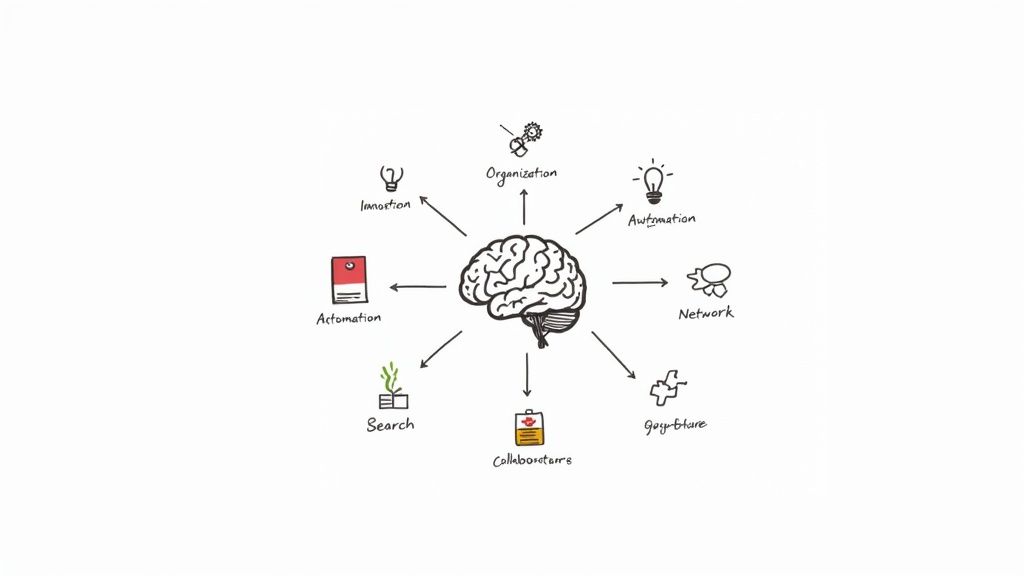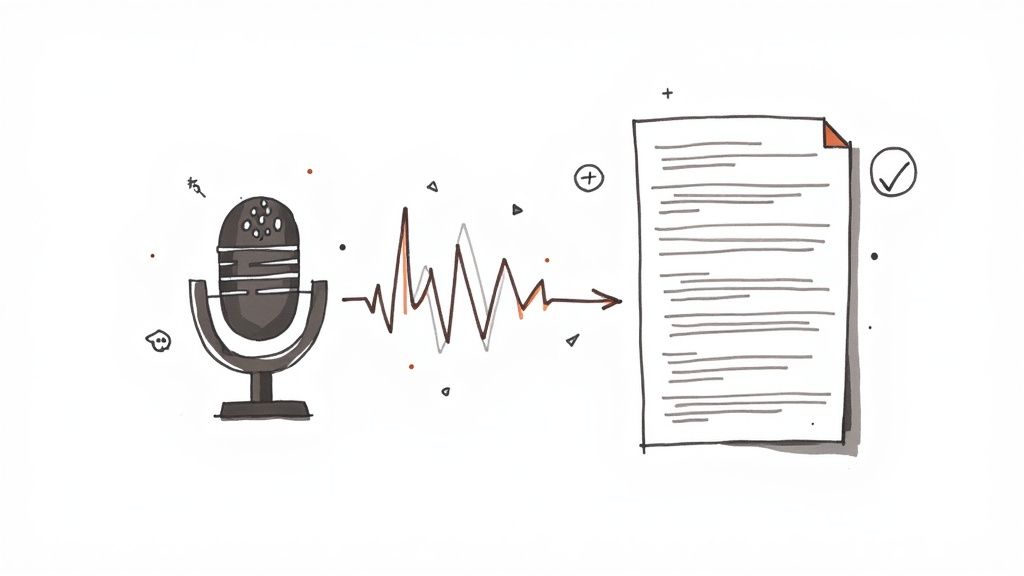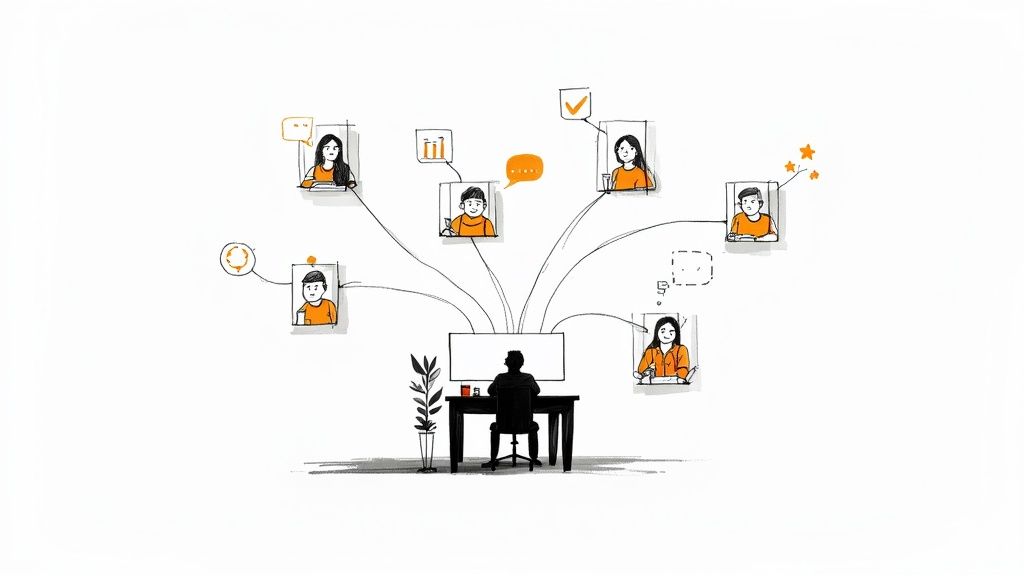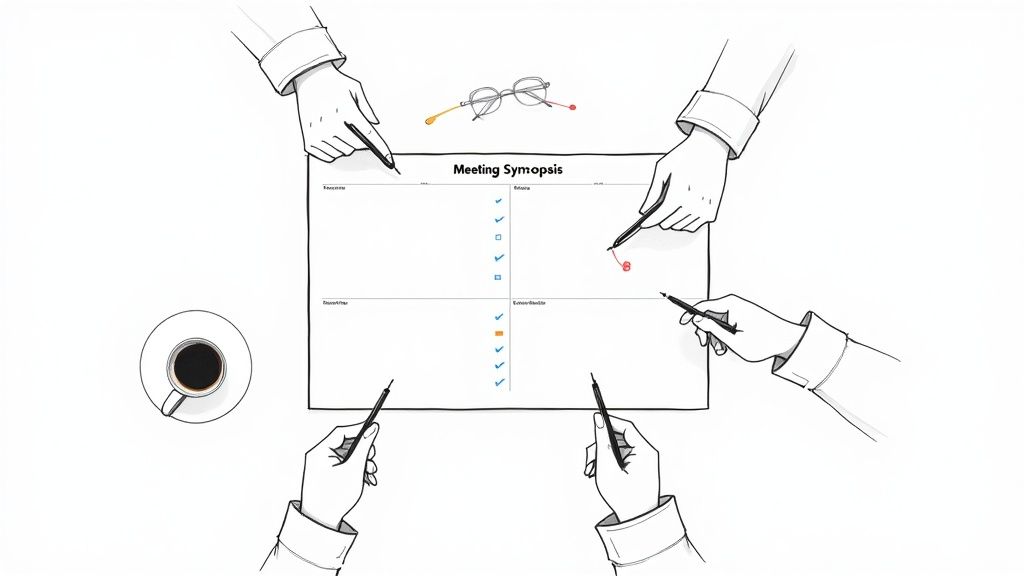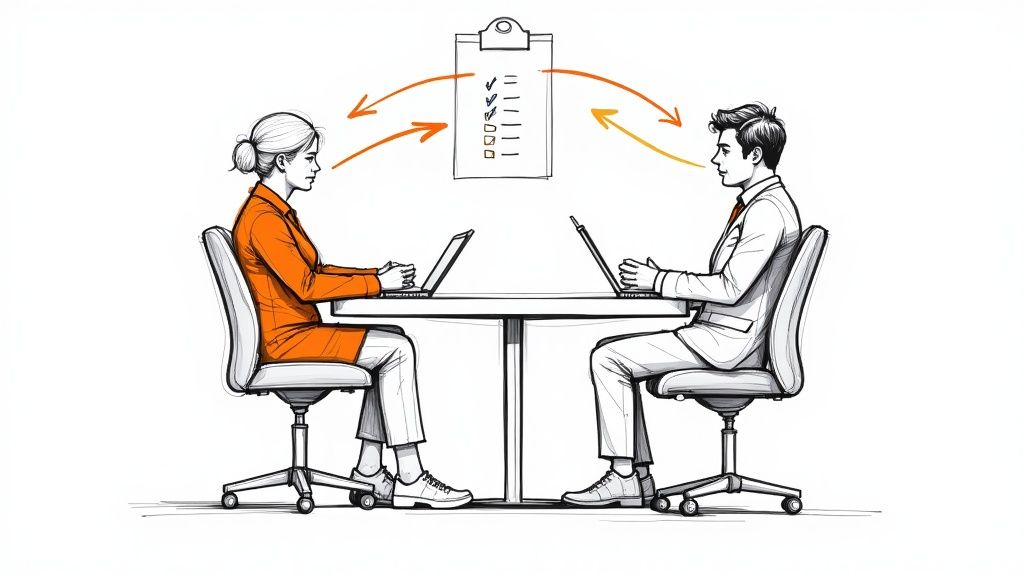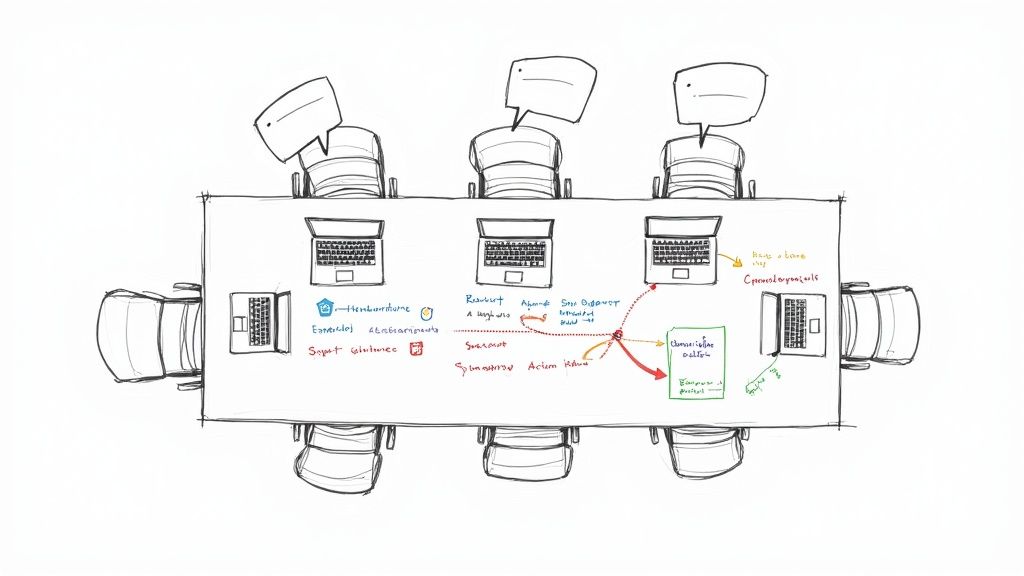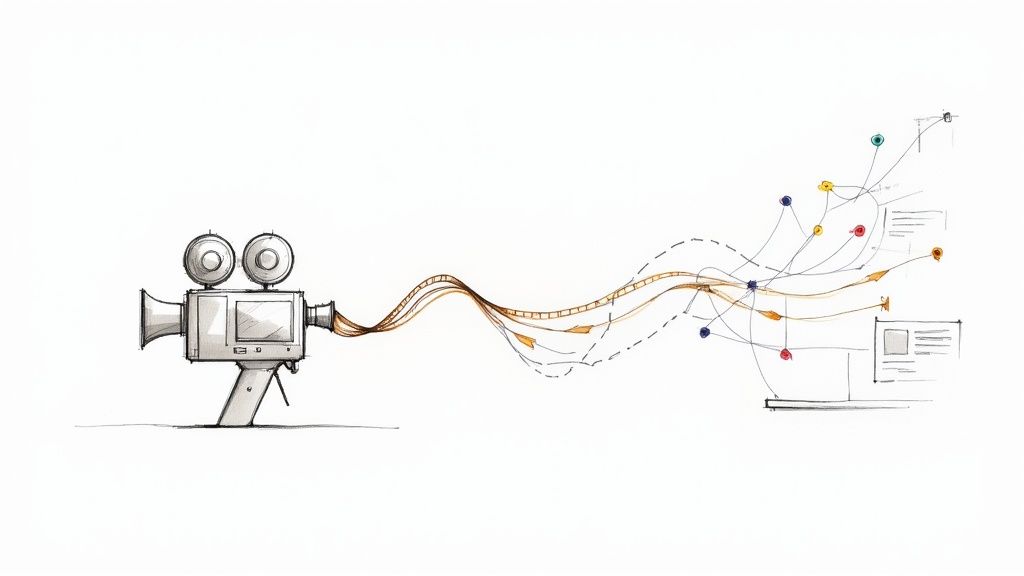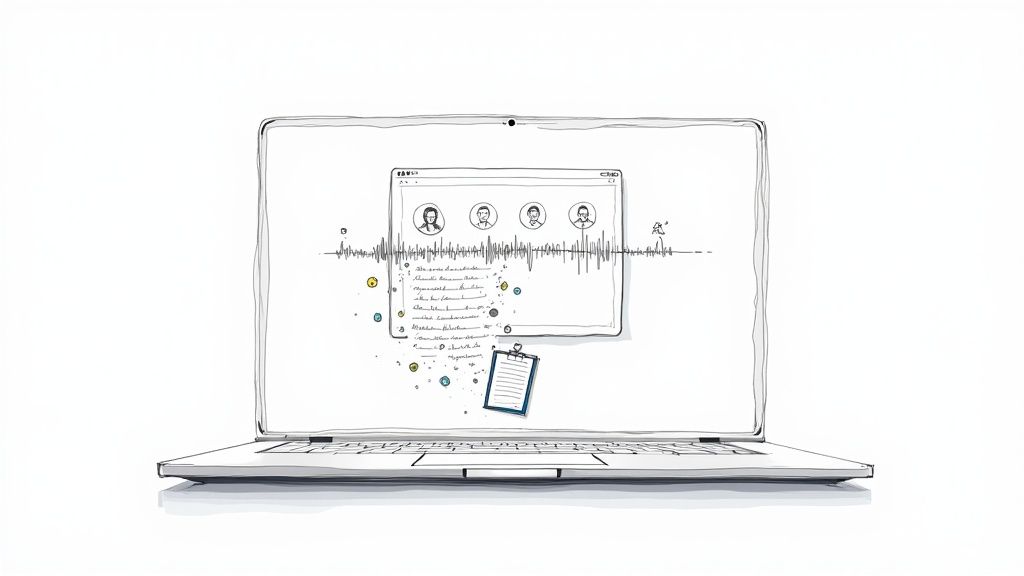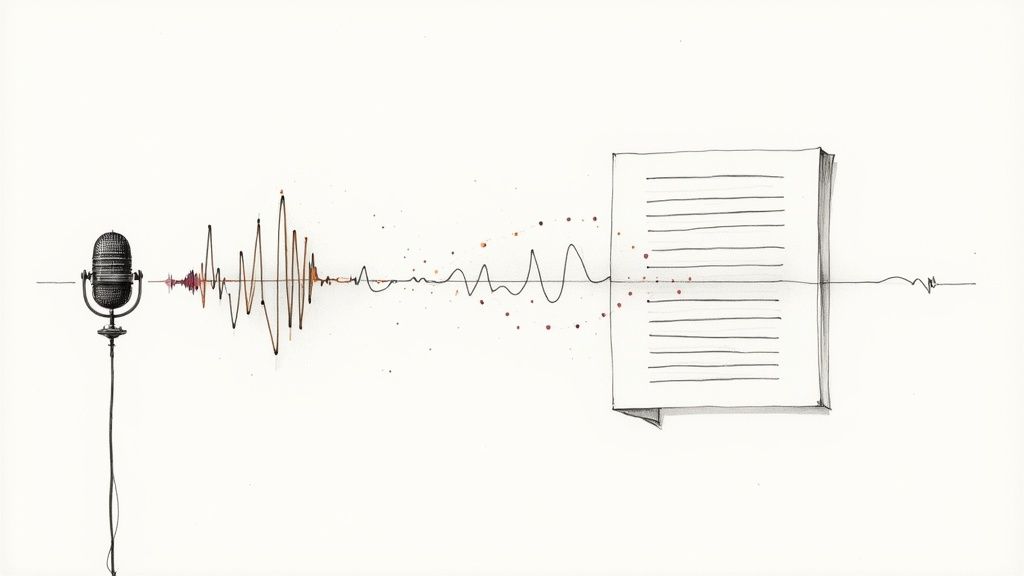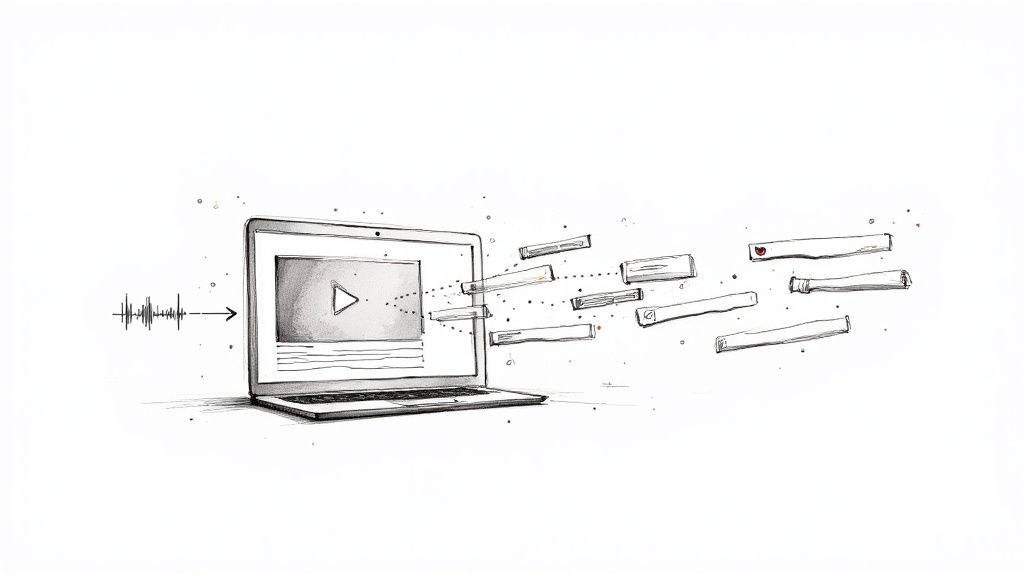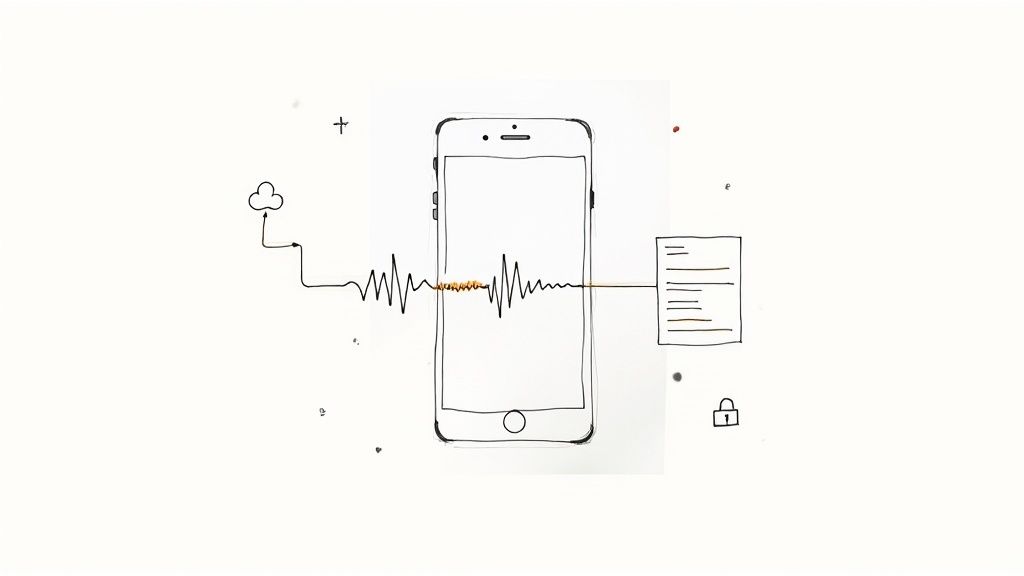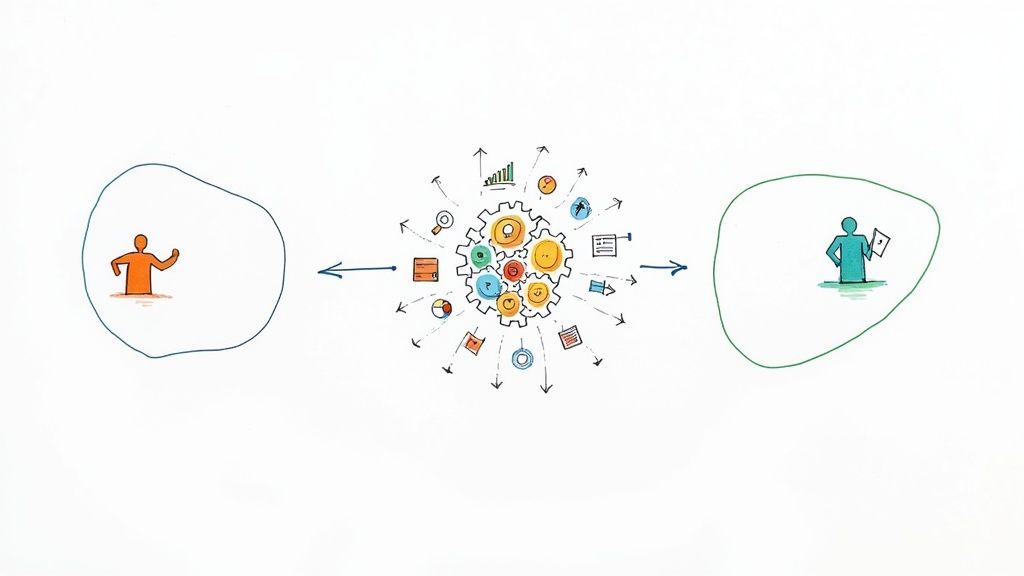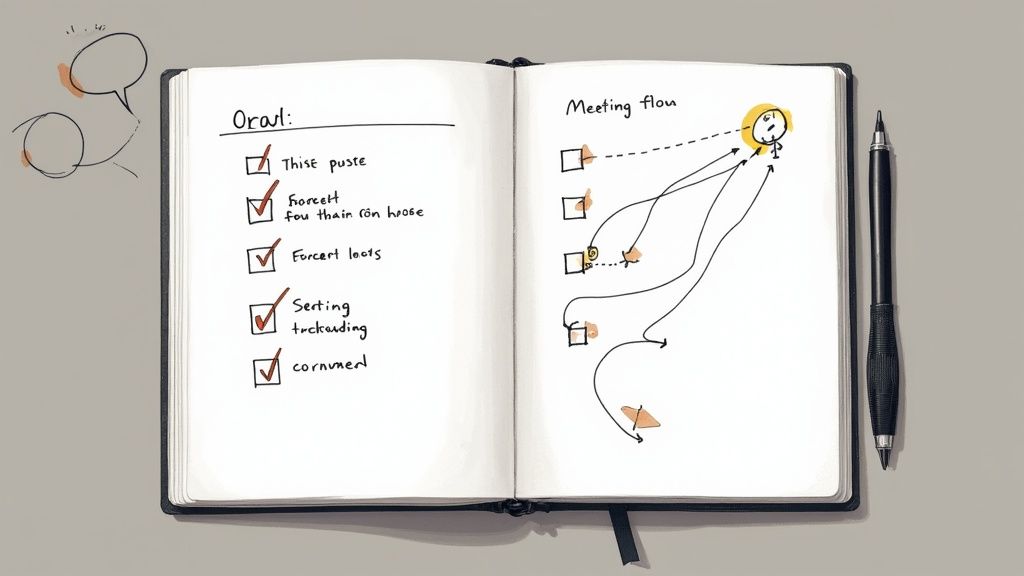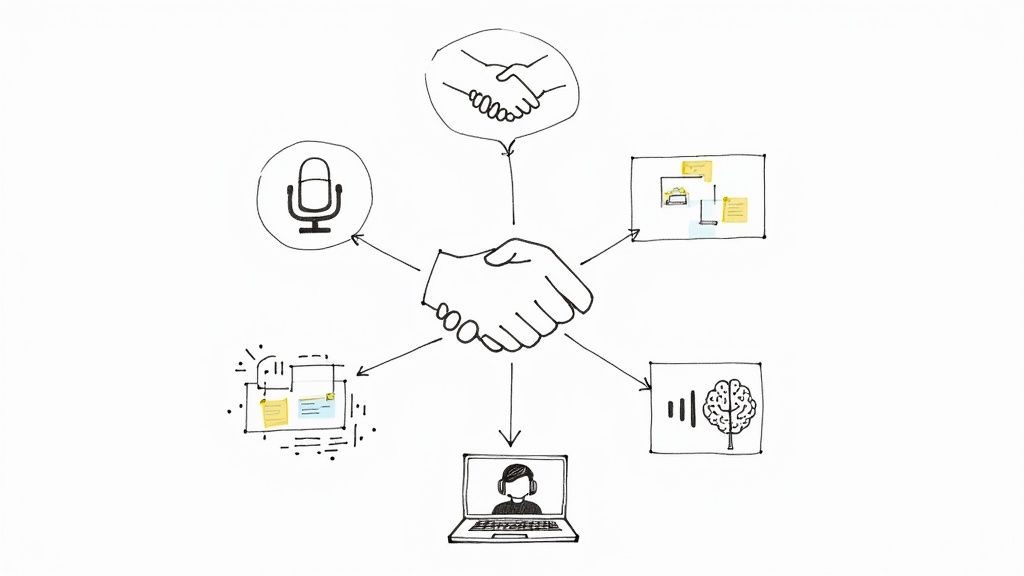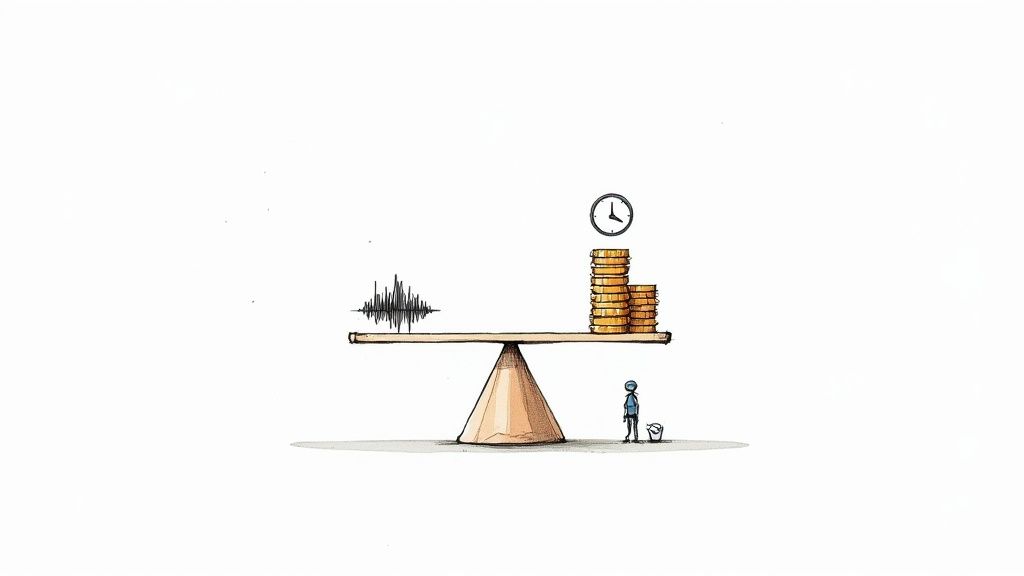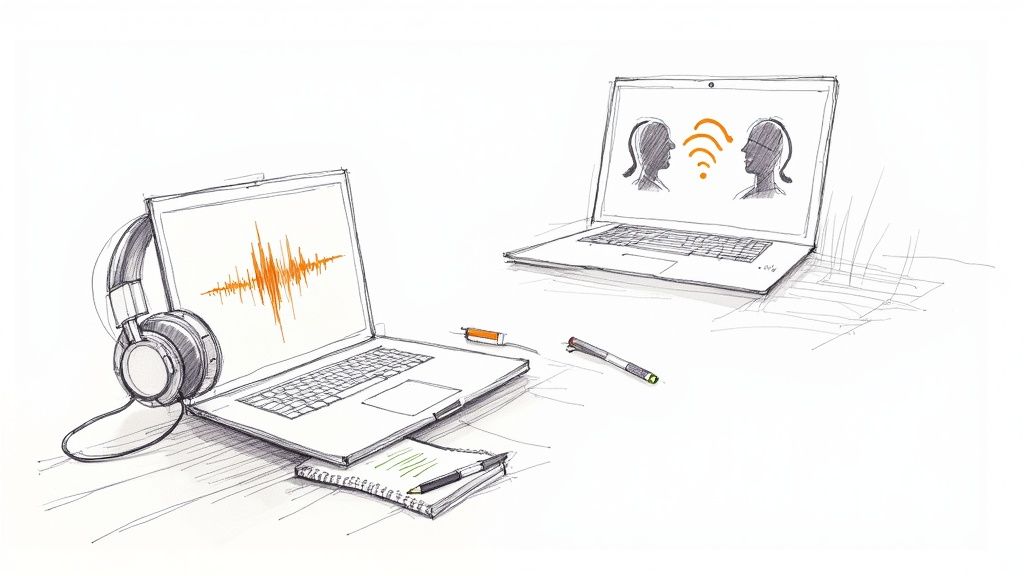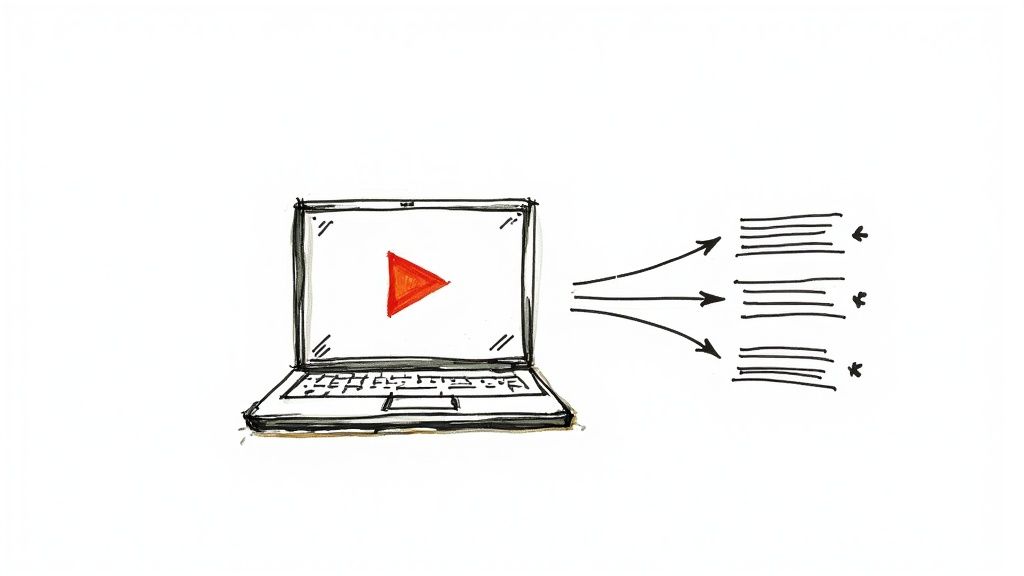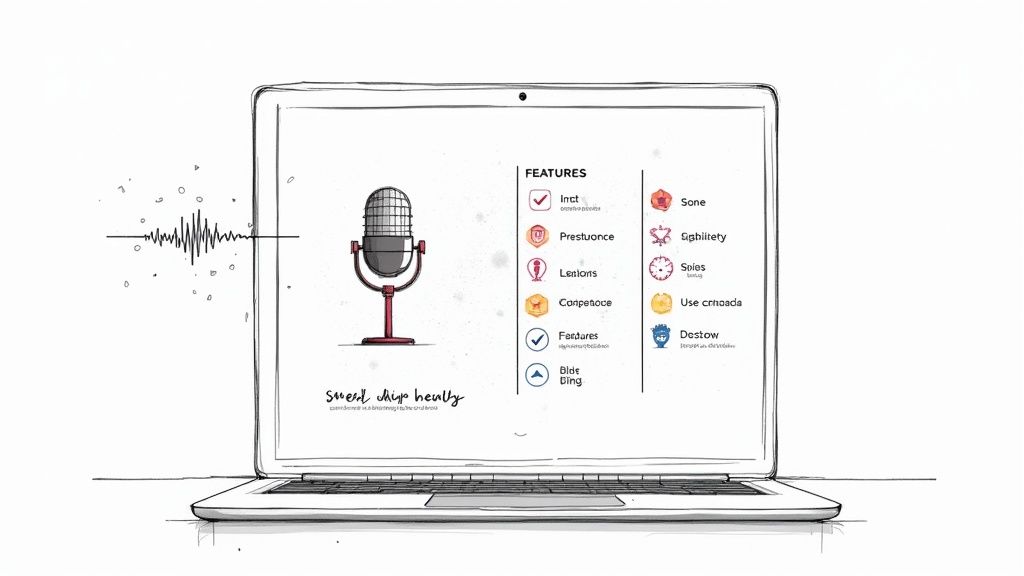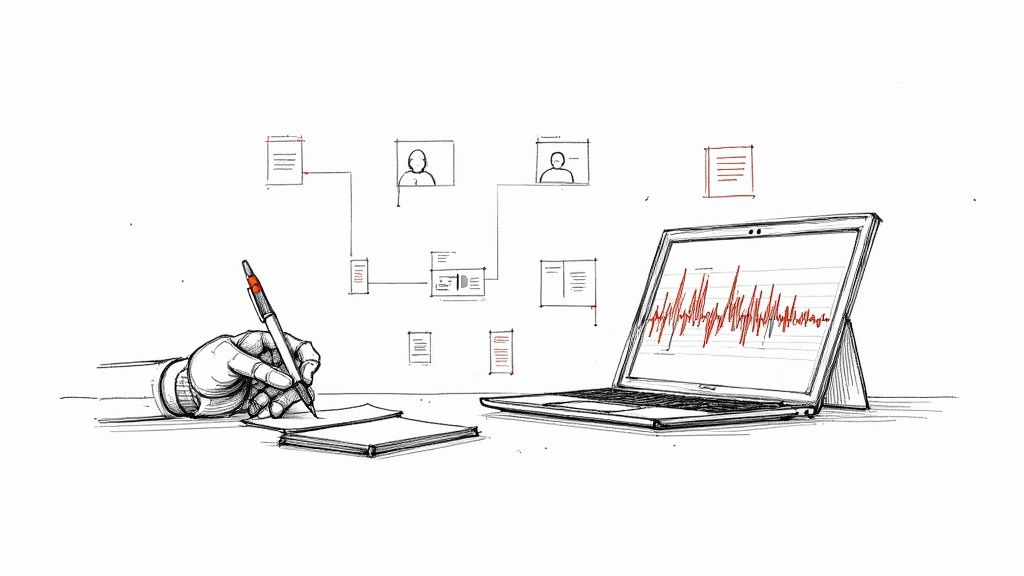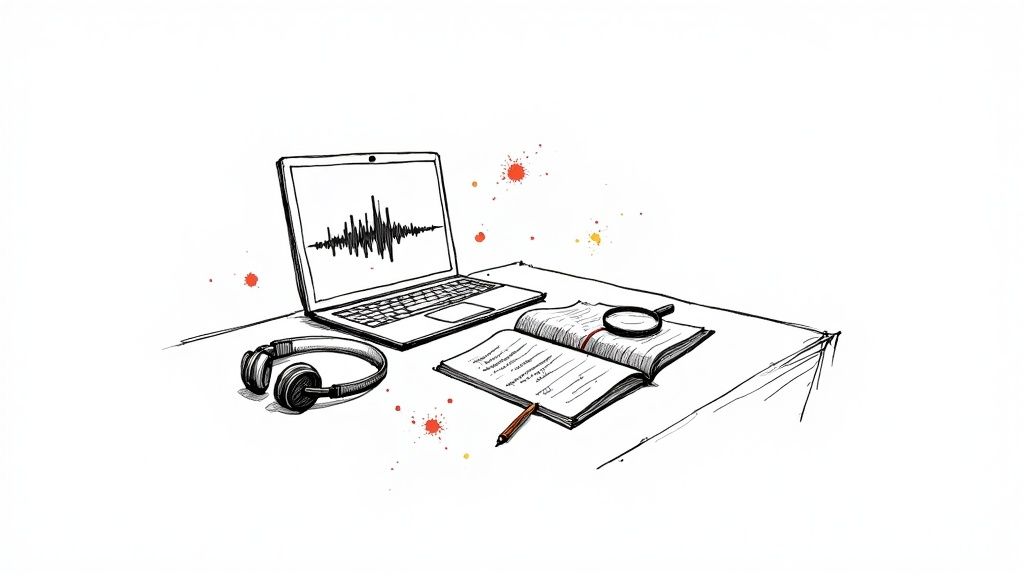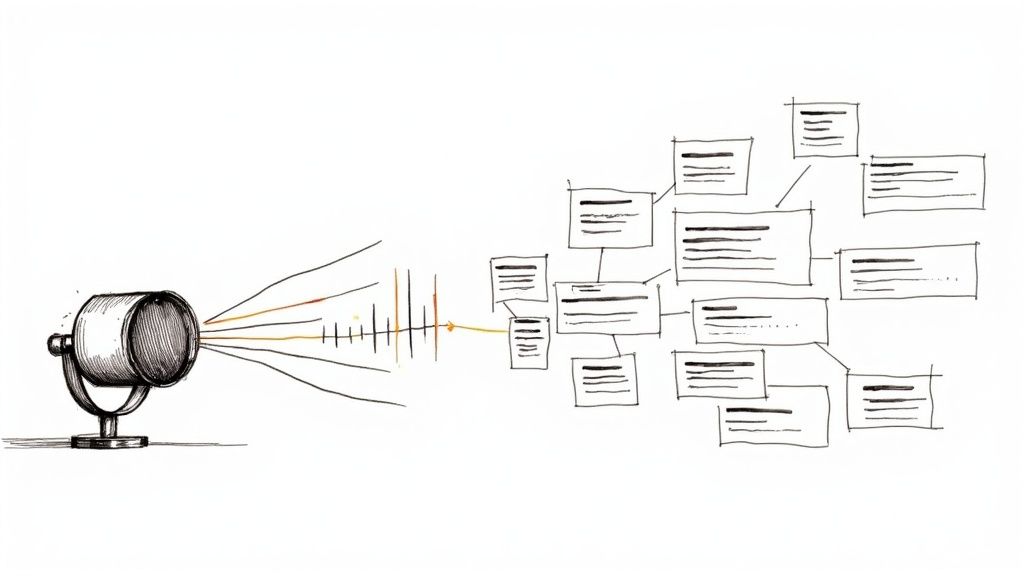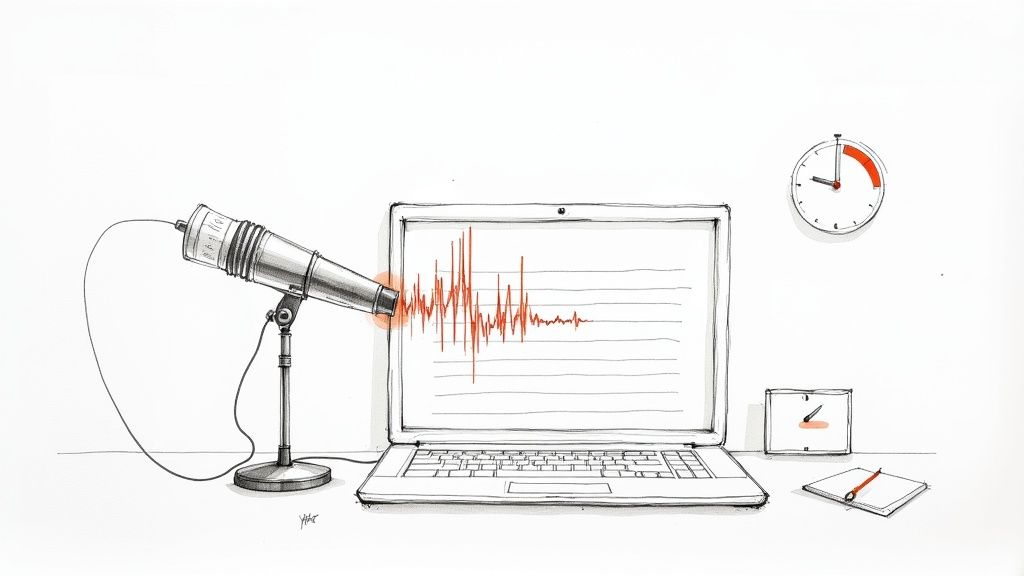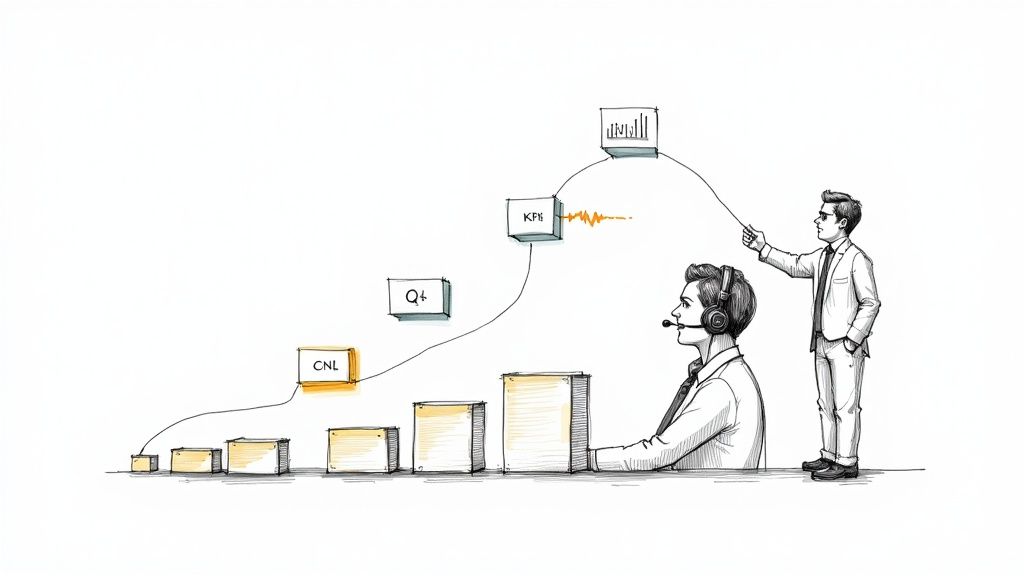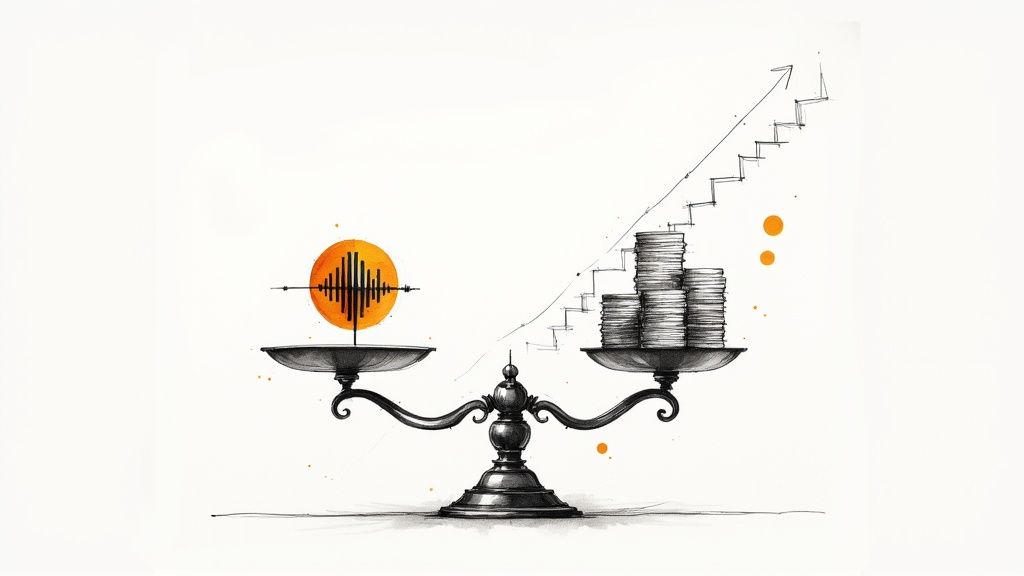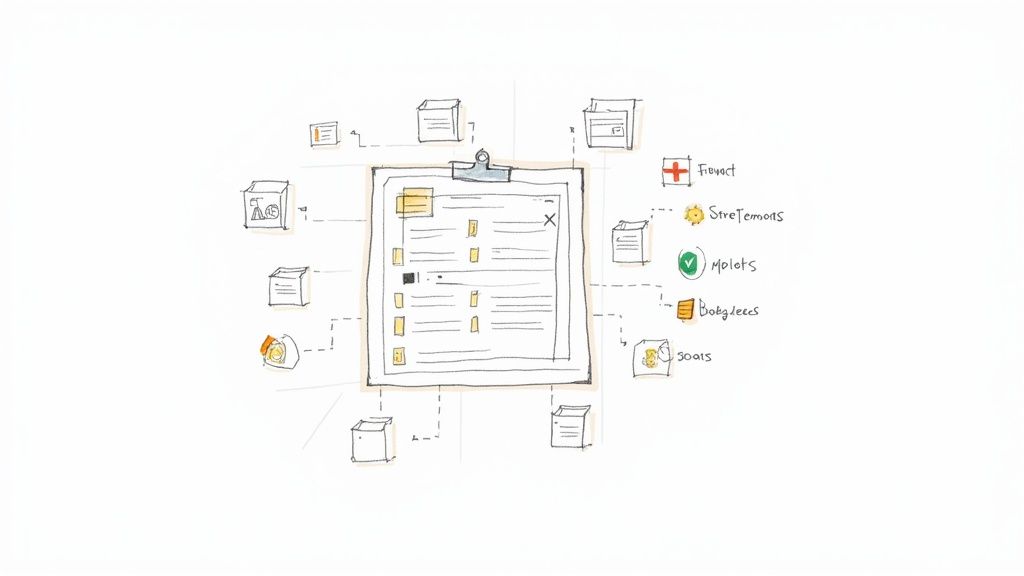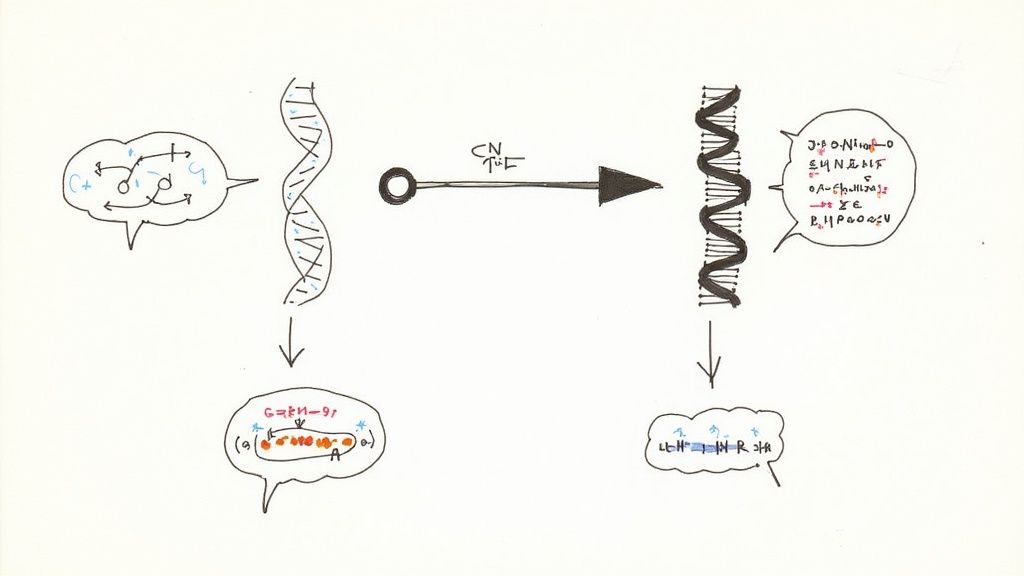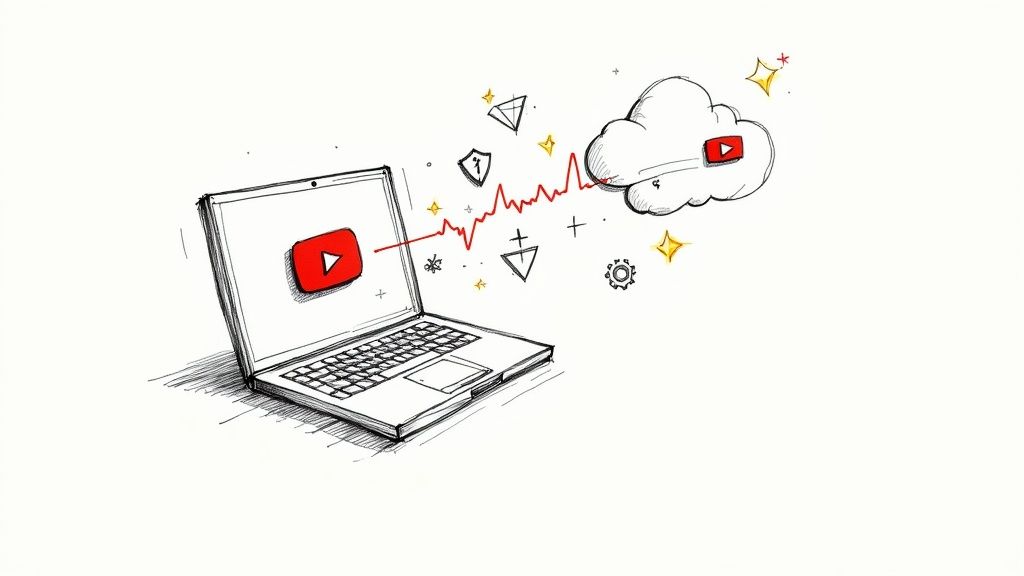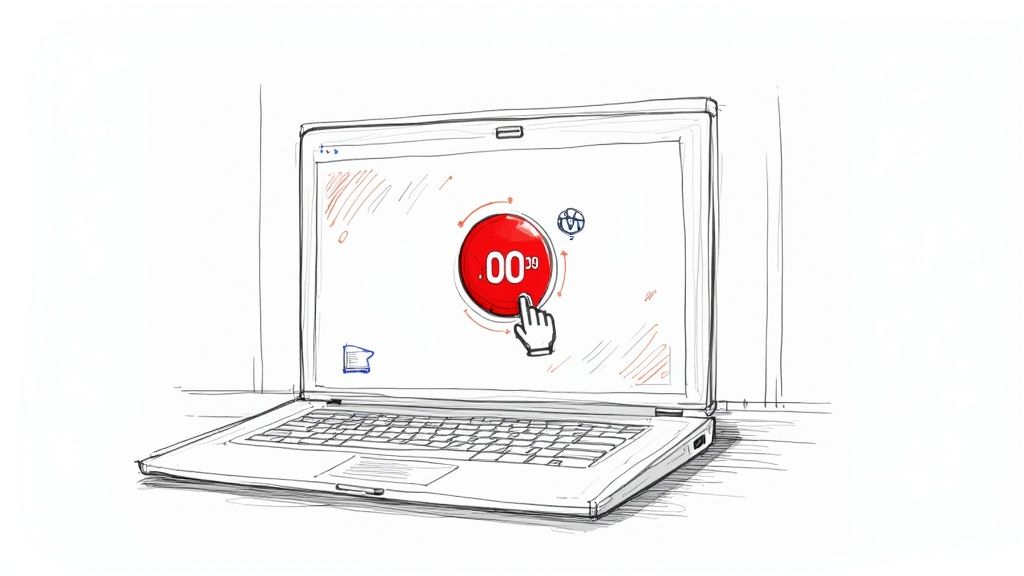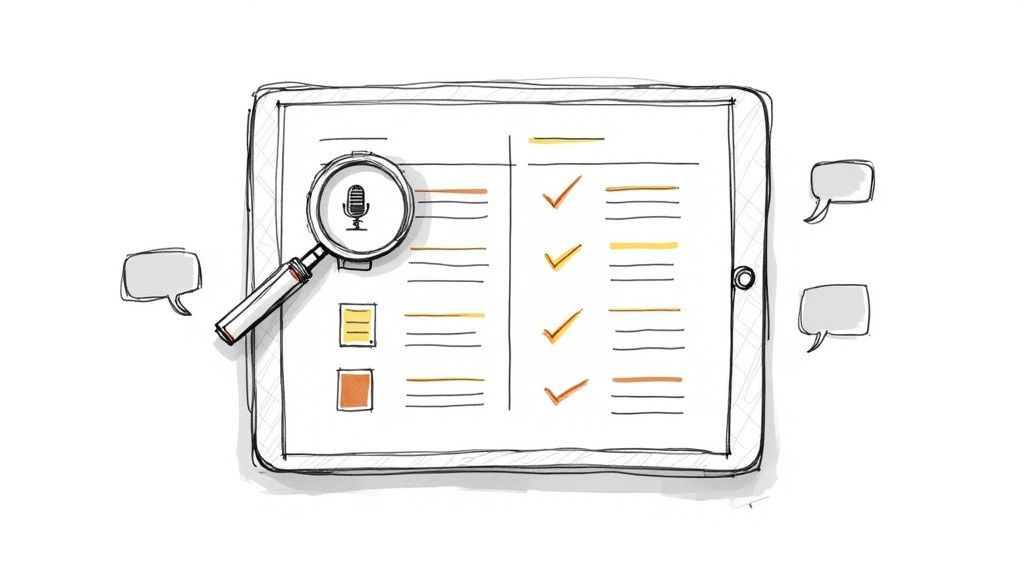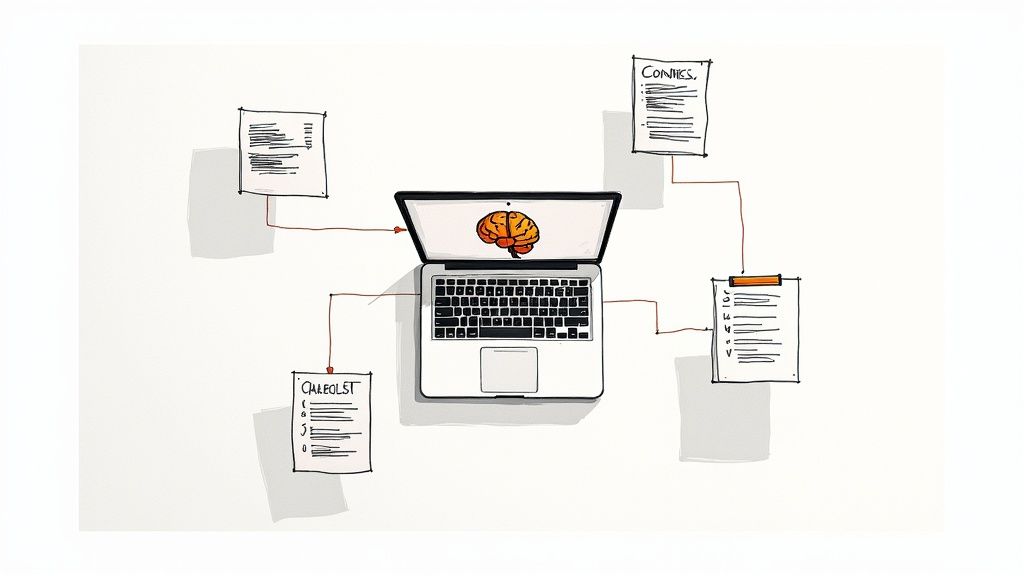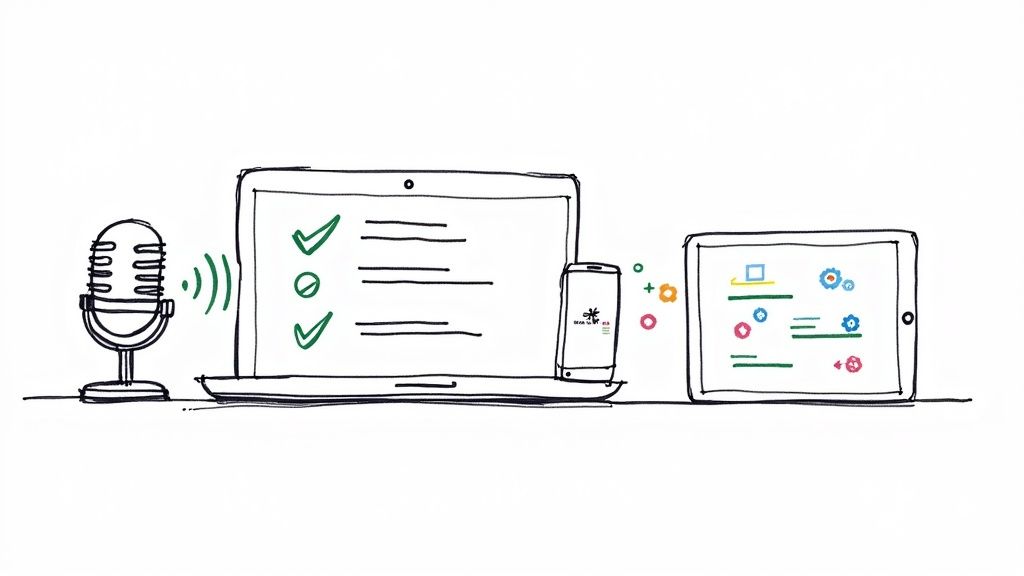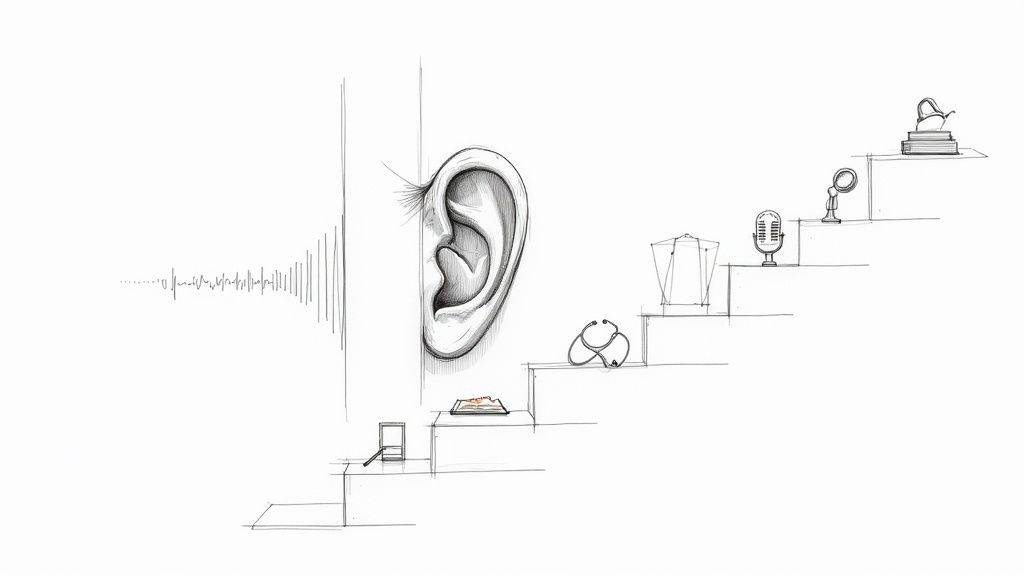Your Guide to Using a Video to Text Converter
Ever found yourself scrubbing through a two-hour webinar just to find that one brilliant quote? Or maybe you've tried turning a fantastic customer interview into a case study, only to get bogged down by the sheer effort of typing it all out. It’s a slow, frustrating process. From my own experience, this is exactly where a video to text converter becomes a game-changer—it’s a smart tool that quickly pulls all the valuable, spoken information out of your video files.
Why Should You Convert Video to Text?
We're all creating and consuming more video than ever, but there's a catch. Raw video files are like locked boxes for search engines and anyone trying to find specific information quickly. For busy professionals, students, or creators, hitting pause-rewind-play to manually type everything out just isn't a realistic option. I've been there, and it's a huge time sink.
A video to text converter solves this problem by automatically turning spoken words into an accurate, readable, and searchable text file. It’s not just a time-saver; it’s about getting the most out of every video you produce. Suddenly, you can repurpose, analyze, and share your content in ways you couldn't before.
What’s Hiding in Your Video Content?
Think of a transcript as a map to your video's treasure. It gives you a solid foundation to build on, opening the door for all sorts of smart strategies. That one video you recorded can now be the starting point for a dozen different pieces of content.
This is a huge deal for anyone trying to work more efficiently and get their message out to more people. It transforms your video library from a passive archive into an active, searchable knowledge base.
Here are a few of the immediate wins you’ll see:
- Breathe New Life into Old Content: Easily spin a single webinar or interview into multiple blog posts, social media snippets, email newsletters, or detailed case studies.
- Make Your Content Accessible to Everyone: Accurate captions and transcripts open your videos up to viewers with hearing impairments, making your message more inclusive.
- Get Noticed by Google: Search engines can't watch a video, but they love to read text. A transcript makes your video's content completely visible to them, helping you rank for important keywords.
- Find What You Need, Fast: Stop re-watching hours of footage. Just use "Ctrl+F" to search your transcript for specific names, topics, or data points in seconds.
At its heart, a video to text converter makes the information inside your videos as useful and flexible as a written document. It turns video from a "watch-only" format into a versatile digital asset you can use again and again.
Ultimately, using this kind of tool is about working smarter. It ensures that every second of video you record delivers the biggest possible impact.
How Does a Video to Text Converter Actually Work?
Ever wondered what’s actually happening under the hood when a video to text converter does its thing? It’s not magic, but it’s pretty close. The simplest way I explain it is like a highly skilled digital assistant who can listen intently, grasp the context of a conversation, and type at superhuman speeds. The end result? Messy audio becomes clean, organized text.
The whole process starts the moment you upload your video. The tool first isolates the audio track, treating it as the raw material. From there, it feeds those soundwaves into a powerful engine known as Automatic Speech Recognition (ASR). This technology is the heart and soul of any modern transcription service.
From Soundwaves to Sentences
So, what does the ASR model do? It meticulously analyzes the audio, breaking down the complex patterns of human speech into the smallest distinct units of sound, called phonemes. Think of these as the basic building blocks of language.
The AI then starts piecing these phonemes together to form words, then phrases, and finally, complete sentences. It's a bit like a digital detective solving an incredibly complex puzzle, constantly cross-referencing a massive library of language data to figure out the most probable sequence of words.
Of course, this is far more sophisticated than old-school dictation software. Today’s advanced converters are trained to tackle the messy realities of real-world audio, which often include:
- Handling Multiple Speakers: Telling the difference between voices in a group discussion.
- Navigating Accents: Understanding and accurately transcribing various regional dialects and pronunciations.
- Filtering Background Noise: Intelligently ignoring distracting sounds like passing sirens, cafe chatter, or keyboard clicks to focus on what’s important.
Adding Structure and Context
A great transcript is more than just a big wall of text. It needs structure to be useful. This is where the more advanced features come in, adding organizational layers that make the final text searchable, scannable, and easy to understand.
A key feature here is speaker diarization. This is the technology that identifies who spoke and when, automatically labeling the dialogue with tags like "Speaker 1" and "Speaker 2".
An accurate transcript isn’t just about getting the words right; it's about capturing the natural flow of the conversation. Features like speaker identification and timestamps transform a simple text file into a functional, searchable record of your video.
This infographic breaks down the difference between the old-school manual process and what a modern AI-powered tool can do.

As you can see, it completely removes that tedious loop of listening, pausing, typing, and rewinding.
Another critical piece of the puzzle is precise timestamping, which syncs every word or phrase to its exact moment in the video. This is a game-changer. It means you can click on any part of the transcript and instantly jump to that specific point in the video, making it incredibly easy to review, find key moments, and edit. To see how these features stack up, it's worth exploring the best auto transcribe software available today.
Choosing the Right Video Transcription Tool for You
With so many video-to-text converters out there, picking the right one can feel overwhelming. The truth is, they aren't all created equal, and the best tool for you really boils down to what you need to accomplish. In my experience, the absolute first thing to look at is accuracy.
You'll see services boasting 99% accuracy, but what does that number actually mean in practice? Think about it: in a 10-minute video, that 1% error rate can translate to about 15 wrong words. If you're just transcribing a personal video, that's no big deal. But for a journalist on a tight deadline or a legal professional who needs every word to be perfect, those little errors add up to a lot of extra work and potential confusion.
Core Features Every Good Converter Needs
Beyond just getting the words right, a genuinely useful tool needs features that make your life easier and your workflow faster. As you compare different options, make sure these fundamentals are covered.
- Multi-Language Support: Your content might be in English today, but what if you need to work with Spanish or French tomorrow? A converter that handles multiple languages gives you the flexibility to work with global teams and reach wider audiences without hitting a wall.
- Speaker Identification: For any video with more than one person talking—like an interview, meeting, or panel discussion—knowing who said what is everything. This feature, sometimes called "diarization," automatically assigns speakers to their lines, transforming a messy block of text into a clean, easy-to-follow script.
- Custom Vocabulary: Does your industry live and breathe acronyms, jargon, or unique brand names? A custom vocabulary feature is non-negotiable. It lets you "teach" the AI these specific terms, which can make a massive difference in accuracy for your niche content.
The real goal isn't just getting a transcript; it's getting a usable transcript without having to spend hours fixing it. Features like speaker labels and custom vocabularies are what separate a basic tool from a professional one that genuinely saves you time.
Advanced Capabilities for Professionals
Once you've ticked off the essentials, it's time to look at the more advanced features that can really supercharge your productivity. This is often where the top-tier services pull away from the pack.
To help you see the difference, here’s a quick breakdown of what separates a basic tool from a professional-grade one.
Essential vs Advanced Converter Features
As you can see, the advanced features are all about creating a smooth, efficient workflow.
Seamless integrations, for example, are a game-changer. Can the tool connect directly to your workflow in places like Google Drive or Zoom? An integrated system saves you from the soul-crushing cycle of downloading a video from one place just to re-upload it to another.
Precise timestamping is another must-have for serious work. The best converters provide word-level timestamps, meaning you can click on any word in the transcript and instantly jump to that exact moment in the video. This makes reviewing, editing, and pulling soundbites incredibly fast.
If you'd like to see how these features stack up in real-world tools, you can explore some of the best AI transcription software currently available. By keeping these key features in mind, you can find a converter that doesn't just work, but works for you.
How Transcribing Video Unlocks New Opportunities
It’s easy to think of a video to text converter as just a handy tool for getting a quick script. But that's only scratching the surface. The real magic happens when you start treating that video transcript as a strategic asset, one that can breathe new life into your entire digital presence.
You're essentially unlocking all the valuable, spoken information trapped inside your video files and putting it to work.

For marketers, this is a game-changer. Let's say you just wrapped up a one-hour webinar. Without a transcript, that content pretty much lives and dies as a single video. But with a transcript? It becomes the raw material for a whole new marketing campaign.
That single wall of text can be carved up into several blog posts, a dozen social media snippets, a deep-dive email newsletter, or even a downloadable guide. All of a sudden, one hour of work can fuel your content calendar for weeks.
Supercharge Your SEO and Accessibility
Here’s a huge one: search engines like Google can't "watch" your video to figure out what it's about. They rely on text. When you add a transcript, you're giving them a word-for-word script to crawl and index.
This means all the expertise you shared in that video can now show up in search results for relevant keywords, driving a fresh stream of organic traffic right to your doorstep.
But it’s not just about search engines. Transcription is the backbone of truly accessible content. That text is what you use to create accurate captions and subtitles, making your videos available to viewers with hearing impairments. It’s a simple step that widens your audience and shows you're committed to inclusivity.
A transcript doesn't just support your video; it multiplies its value. It makes your content discoverable by search engines, accessible to a broader audience, and infinitely easier to repurpose for other marketing channels.
Real-World Strategic Applications
The ripple effects of video transcription go well beyond marketing. Across different fields, people are finding smart ways to use this technology to work smarter and uncover hidden insights.
- In Education: Students and researchers can instantly transcribe lectures and interviews. This creates searchable study guides, making it a breeze to find that one specific quote for a research paper.
- For Corporate Training: Companies can turn video training sessions into text-based modules. This lets employees learn at their own pace and quickly look up key procedures without scrubbing through a long video.
- During Market Research: Analysts can transcribe focus groups and customer interviews. This allows them to spot trends, pull compelling quotes, and analyze feedback without having to re-watch hours of footage.
You can see this trend in the explosive growth of related markets. The video conferencing transcribing market, for example, was valued at $0.806 billion and is expected to climb to $1.18 billion by 2033, according to Business Research Insights. That growth is a direct result of the shift to remote work and the massive demand for reliable transcription in our daily communication.
For creators, using a YouTube video to text converter can drastically cut down the time it takes to get from a finished video to a polished blog post. At the end of the day, transcribing your video isn’t just a task to check off—it’s a powerful strategy for growing your audience, boosting engagement, and making your operations more efficient.
Why HypeScribe Delivers Superior Performance
Sure, plenty of tools can convert video to text. But when you get down to it, the difference between a basic tool and a great one is in the details. We built HypeScribe from the ground up to tackle the real-world frustrations people face with transcription. It’s not just about getting the words down; it’s about making the entire process faster and more intuitive.

It really all starts with accuracy. We’ve spent countless hours tuning our AI to perform reliably, even when the audio is less than perfect. Think about a busy meeting with people talking over each other, a podcast with guests from different parts of the world, or an interview recorded in a noisy café. HypeScribe is designed to handle those messy situations with precision.
That level of accuracy means the transcript you get back is incredibly clean, saving you a ton of time on manual edits and proofreading.
An Interface Designed for Speed
A powerful video to text converter isn't much help if it's a pain to use. We obsessed over making the HypeScribe interface feel simple and fast. Every step, from uploading your video to exporting the final text, is designed to be second nature.
The interactive editor is where this really shines. You can click on any word in the transcript, and it instantly syncs you to that exact spot in the video. This completely changes the game for editing, turning what used to be a tedious process of scrubbing through a timeline into a quick and easy review.
HypeScribe's core advantage lies in its ability to combine exceptional accuracy with a user-friendly design. It’s a tool built not just to transcribe, but to accelerate your entire workflow from video to finished document.
Unique Features for Modern Teams
HypeScribe is also built for the way teams work today—collaboratively. We know that getting a transcript is often just the first step. The real work happens when your team needs to review, summarize, and act on that information together.
Here’s where HypeScribe really stands out:
- Real-Time Collaboration: Imagine your whole team jumping into a transcript at the same time to edit, add comments, and finalize meeting notes. That’s exactly what you can do. It's a lifesaver for creating accurate summaries or prepping video subtitles together.
- Actionable Summaries: Our AI does more than just type out what was said. It can generate smart summaries that pull out the key points and even identify specific action items. This turns a long, rambling discussion into a clear, concise list of what needs to happen next.
- Searchable Archives: Over time, HypeScribe transforms all your video content into a searchable knowledge base. Need to remember what was decided about a certain project three months ago? Just type in a keyword. HypeScribe will find the exact moment in the right video, saving you from an afternoon of digging.
By focusing on accuracy, usability, and features that support teamwork, HypeScribe offers a smarter way to get real value out of all your video content.
The Future of AI-Powered Transcription
The technology behind any solid video to text converter is moving incredibly fast. The tools we have today are already impressive, but the next wave of AI is poised to weave transcription even deeper into our daily work. Accuracy rates, which can hit 99% under the right conditions, are only going to get better, making AI transcription virtually indistinguishable from a human's.
But this evolution isn't just about nailing every single word. We're heading towards a future where these tools don't just listen and type—they actually understand and analyze the content.
Beyond Words to Intelligent Insights
Picture an AI that doesn't just hand you a script but also flags the emotional tone of a conversation. That's the idea behind sentiment analysis, a feature that could pinpoint moments of frustration on a customer service call or genuine excitement during a brainstorming session. This gives businesses a much richer layer of insight into their conversations.
And it doesn't stop there. Future tools are shaping up to be real productivity partners. The next generation of transcription AI will be great at:
- Whipping up smart summaries that boil down an hour-long meeting into its most crucial takeaways.
- Automatically spotting action items and suggesting who should be assigned to them.
- Offering real-time translation, finally tearing down language barriers on international calls.
The real aim is to turn a static transcript into a dynamic, interactive resource. The AI won't just tell you what was said; it will help you grasp what it means and decide what to do next.
Putting a powerful transcription tool in your corner today is more than just a simple workflow upgrade. It's about getting ready for a future where AI-driven communication is the norm, freeing you up to focus less on taking notes and more on making things happen.
Answering Your Questions About Video to Text Converters
Even after seeing what a video to text converter can do, it's normal to have some practical questions pop up. Let's tackle some of the most common ones I hear from people just starting out. I'll give you straight answers on everything from accuracy to what separates free tools from professional ones.
Just How Accurate Are These Converters?
This is the big one, right? The short answer is: surprisingly accurate. Modern AI can hit 95-99% accuracy, but that number comes with a big "if"—it all hinges on the audio quality. If you feed it a video with crystal-clear sound, no background noise, and one person speaking clearly, the transcript will be nearly perfect.
But the real world is messy. Things like thick accents, people talking over each other, or specialized industry jargon can trip up the AI. That's why for serious work, you should look for tools that let you build a custom vocabulary. This feature is a game-changer for getting technical terms right. A good rule of thumb is to let the AI do the heavy lifting and then give the transcript a quick human once-over to catch any subtle mistakes.
The best video to text converter tools don't just brag about accuracy. They give you a fantastic first draft and the editing tools you need to easily polish it to 100% for whatever you need.
What Kind of Video Files Can I Upload?
Flexibility is a huge plus here. Most professional platforms are built to handle just about any standard video file you can throw at them, so you're rarely stuck.
You'll almost always find support for the big ones:
- MP4: The universal format for pretty much all web and mobile video.
- MOV: A high-quality format you'll see a lot if you're doing video editing.
- WMV: The go-to format in the Windows world.
- AVI: An older format, but it's still hanging around and well-supported.
Even better, many services like HypeScribe let you skip the whole download-and-re-upload dance. You can often just paste a link from YouTube or Google Drive and let the tool pull the video directly. It's a massive time-saver.
What’s the Real Difference Between Free and Paid Tools?
When you boil it down, the main differences are accuracy, features, and limits. A free tool can be fine if you just need to transcribe a short, simple clip for personal use. But they almost always come with strings attached, like limiting how long your file can be or how many you can convert per month.
You'll also find they're missing the power features—things like telling you who is speaking, learning custom words, or letting your team work together on a transcript. Paid services, on the other hand, are built for professional results. You get much higher accuracy, the full suite of features, better security for your data, and actual customer support if you get stuck. For any business, academic, or serious content work, it's really the only way to go.
Ready to see what a professional-grade video to text converter can do for you? Give HypeScribe a try and watch your video content become useful, searchable text in just a few moments. You can get started for free on the HypeScribe website.



